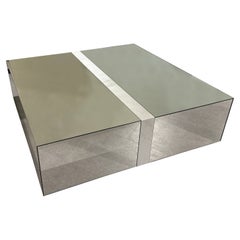Legado Coffee Table With Mirror And Marble Combined
21st Century and Contemporary Portuguese Modern Center Tables
Marble
People Also Browsed
21st Century and Contemporary Swedish Mid-Century Modern Table Lamps
Textile
21st Century and Contemporary Portuguese Modern Night Stands
Wood
A Close Look at Modern Furniture
The late 19th and early 20th centuries saw sweeping social change and major scientific advances — both of which contributed to a new aesthetic: modernism. Rejecting the rigidity of Victorian artistic conventions, modernists sought a new means of expression. References to the natural world and ornate classical embellishments gave way to the sleek simplicity of the Machine Age. Architect Philip Johnson characterized the hallmarks of modernism as “machine-like simplicity, smoothness or surface [and] avoidance of ornament.”
Early practitioners of modernist design include the De Stijl (“The Style”) group, founded in the Netherlands in 1917, and the Bauhaus School, founded two years later in Germany.
Followers of both groups produced sleek, spare designs — many of which became icons of daily life in the 20th century. The modernists rejected both natural and historical references and relied primarily on industrial materials such as metal, glass, plywood, and, later, plastics. While Bauhaus principals Marcel Breuer and Ludwig Mies van der Rohe created furniture from mass-produced, chrome-plated steel, American visionaries like Charles and Ray Eames worked in materials as novel as molded plywood and fiberglass. Today, Breuer’s Wassily chair, Mies van der Rohe’s Barcelona chair — crafted with his romantic partner, designer Lilly Reich — and the Eames lounge chair are emblems of progressive design and vintage originals are prized cornerstones of collections.
It’s difficult to overstate the influence that modernism continues to wield over designers and architects — and equally difficult to overstate how revolutionary it was when it first appeared a century ago. But because modernist furniture designs are so simple, they can blend in seamlessly with just about any type of décor. Don’t overlook them.
Finding the Right Center-tables for You
An alluring sitting area doesn’t have to be in the exact center of the room, but an antique or vintage center table is a great tool to partition off such an area.
By definition, a center table is a piece of furniture that is placed in the center of a room. Initially these appeared in the foyer or entryway before making their way into the living room. While one might keep seating furniture such as sofas against the walls to avoid limiting movement and closing off space, a center table in the living room can fill this central space without restricting the flow of the room.
One of the purposes of a center table is to anchor the rest of the furniture. It draws the eye to a specific area and invites guests to sit down. When thinking about how you’ll arrange your furniture, a good rule of thumb is to set tables an arm’s length away from seating. For instance, place a coffee table about 18 inches from a sofa so that it is within reach but not too close. In more modern layouts, tables are sometimes placed to the side to leave a large open area for foot traffic.
Because of its central position, a center table is one of the first things people will notice when entering a room. It’s important to consider how a center table can add to a room, as it’s a crucial element for defining the feel and theme of a room. Some center tables are mainly for decor, while others can be a great place to sit around over cocktails and hors d’oeuvres. Center tables are perfect for displaying decorative objects, floral arrangements, books or a cluster of prized antique vases given the prominent position of your table and the attention it will get.
The clean lines and organic forms that we typically associate with mid-century modern center tables means that they will bring a dose of sophistication to a space, and examples from the era can be found in square and round shapes. Wood tables were popular with furniture makers of the period, but versions in glass and marble are also widely available. Because Art Deco designers frequently incorporated ornamental embellishments such as exotic animal hides and veneers in their seating, case pieces and other furniture, your Art Deco center table will likely make a strong statement in any room. Alternatively, if you’re searching for something small and unassuming, Regency tables could be an option for your space.
Find a growing collection of antique and vintage center tables on 1stDibs today.
Read More
Why Drew McGukin’s Colorful Home Differs from Those of His Clients
The New York–based designer has a high-impact style that's all his own, as his loft in the Chelsea Flower District makes abundantly clear.
New Orleans’ Lee Ledbetter Makes Design Magic by Mixing Past and Present
The Louisiana-born and -bred architect talks to 1stdibs about the art of making timeless places that matter.
How a Modernist Hamptons Home on the Water Became the Ideal Weekend Refuge
Damon Liss and Stelle Lomont Rouhani Architects collaborated on this serene getaway for a minimalism-minded Manhattan family of four.
Desert Modern Designer Arthur Elrod Finally Gets His Day in the Sun
The Palm Springs interior decorator developed a mid-century style that defined the vacation homes of celebrities and other notables, including Bob Hope and Lucille Ball.
Artelinea, Mexico City’s One-Stop Contemporary Design Shop, Paves the Way for a New Wave of Mexican Designers
Wielding her influence on the international scene, founding partner Andrea Cesarman expands the platform for Mexican artisans.
From the Hamptons to Palm Springs, FormArch’s Homes Embody Both Comfort and Cool
The houses from this New York studio cloak modernist tendencies within what are often more traditional trappings.
Wendy Haworth’s Luminous Spaces Epitomize L.A. Ease
For the California designer, authenticity and the unusual are the keys to cool, timeless interiors.
